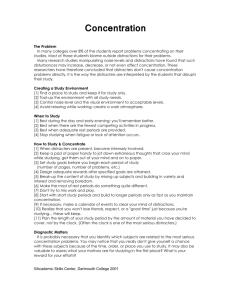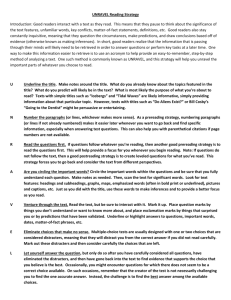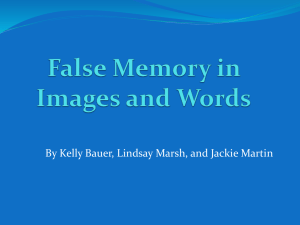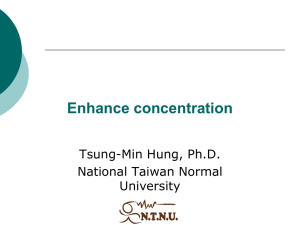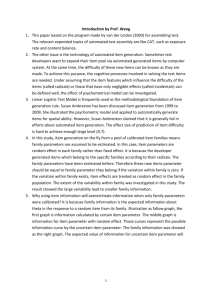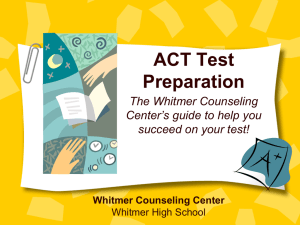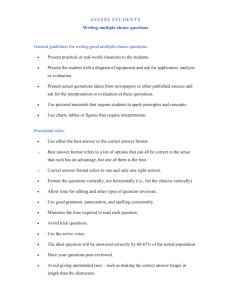Laboratory Report, APA Style (Psychology)
advertisement
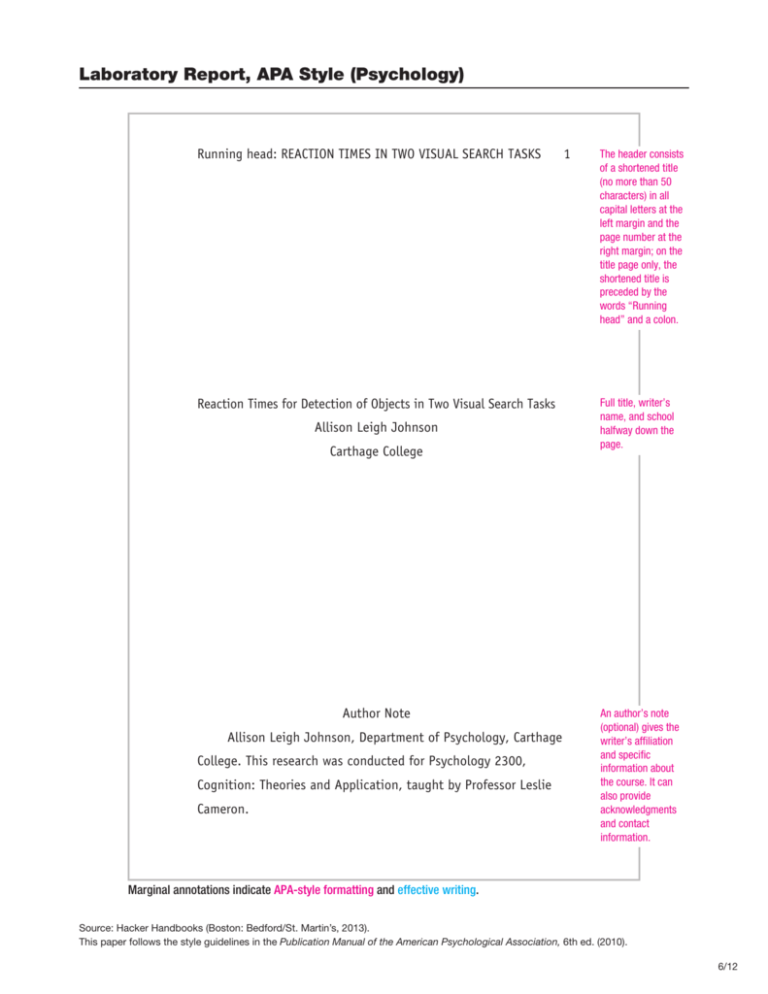
Laboratory Report, APA Style (Psychology) Running head: REACTION TIMES IN TWO VISUAL SEARCH TASKS Reaction Times for Detection of Objects in Two Visual Search Tasks Allison Leigh Johnson Carthage College Author Note Allison Leigh Johnson, Department of Psychology, Carthage College. This research was conducted for Psychology 2300, Cognition: Theories and Application, taught by Professor Leslie Cameron. 1 The header consists of a shortened title (no more than 50 characters) in all capital letters at the left margin and the page number at the right margin; on the title page only, the shortened title is preceded by the words “Running head” and a colon. Full title, writer’s name, and school halfway down the page. An author’s note (optional) gives the writer’s affiliation and specific information about the course. It can also provide acknowledgments and contact information. Marginal annotations indicate APA-style formatting and effective writing. Source: Hacker Handbooks (Boston: Bedford/St. Martin’s, 2013). This paper follows the style guidelines in the Publication Manual of the American Psychological Association, 6th ed. (2010). 6/12 REACTION TIMES IN TWO VISUAL SEARCH TASKS Abstract, a 100to-150-word overview of the paper, appears on a separate page. The heading is centered and not boldface. Abstract Visual detection of an object can be automatic or can require attention. The reaction time varies depending on the type of search task being performed. In this visual search experiment, 3 independent variables were tested: type of search, number of distracters, and presence or absence of a target. A feature search contains distracters notably different from the target, while a conjunctive search contains distracters with features Numerals are used for all numbers in the abstract, even numbers under 10. similar to the target. For this experiment, 14 Carthage College students participated in a setting of their choice. A green circle was the target. During the feature search, reaction times were similar regardless of the number of distracters and the presence or absence of the target. In the conjunctive search, the number of distracters and the presence or absence of the target affected reaction times. This visual search experiment supports the idea that feature searches are automatic and conjunctive searches require attention from the viewer. Keywords (optional) help readers search for a paper online or in a database. Keywords: visual search, cognition, feature search, conjunctive search Source: Hacker Handbooks (Boston: Bedford/St. Martin’s, 2013). 2 REACTION TIMES IN TWO VISUAL SEARCH TASKS 3 Reaction Times for Detection of Objects in Two Visual Search Tasks Vision is one of the five senses, and it is the sense Full title, repeated and centered, not boldface. trusted most by humans (Reisberg, 2010). We use our vision for everything. We are always looking for things, whether it is where we are going or finding a friend at a party. Our vision detects the object(s) we are looking for. Some objects are easier to detect than others. Spotting your sister wearing a purple shirt in a crowd of boring white shirts is automatic and can be done Introduction briefly describes previous research on the topic and provides background on the writer’s experiment. with ease. However, if your sister was also wearing a white shirt, it would take much time and attention to spot her in that same crowd. The “pop out effect” describes the quick identification of an object being searched for because of its salient features (Reeves, 2007). When you look for your sister wearing a purple shirt, for example, you use the pop out effect for quick identification. The pop out effect works when attention is drawn to a specific object that is different from the surrounding objects. Two types of searches are used to scan an environment, the feature search and the conjunctive search (Reeves, 2007). The feature search is simply scanning the environment for the feature or features of a target. The conjunctive search is scanning for a combination of features (Reeves, 2007). Other objects that possess one of the features being searched for are called distracters. Distracters, as the name suggests, draw one’s attention away from the target. When one object is being searched for in a sea of repetitious different objects, the target is easily found because it is unique. As more distracters are added, the time to detect the target increases (Wolfe, 1998). Source: Hacker Handbooks (Boston: Bedford/St. Martin’s, 2013). Johnson uses second-person pronouns (you ) when giving an everyday example to explain a complex concept. REACTION TIMES IN TWO VISUAL SEARCH TASKS 4 Treisman’s (1986) feature integration theory explained that single-feature searches are easy because they are automatic and that attention is required when more features are added because these items must be mentally constructed. This is demonstrated in visual search experiments. The purpose of a visual search experiment is for the participant to identify the target as fast as possible. In my visual search experiment, the target was a green Johnson states her hypothesis at the end of the introduction. circle. The hypothesis of the experiment was that the green circle would be easier to detect in a feature search than in a conjunctive search because, according to Treisman’s theory, attention is needed for the latter task. A lab report typically has three main headings: Method, Results, Discussion. Main headings are boldface and centered. Secondlevel headings are boldface and flush left. Method Participants Fourteen Carthage College undergraduates participated. Four were male. All were 19 to 21 years old. Materials The experiment was conducted in an environment of each participant’s choice, typically in a classroom or library, using the ZAPS online psychology laboratory (2004). Procedure In the feature search, orange squares were the distracters, and a green circle was the target. The conjunctive search contained distracters of orange circles, green squares, and orange squares, with the green circle as the target. For every trial under both Numbers 10 and above are expressed as numerals; numbers below 10 are spelled out (except when used with specific units of measure). Numbers that begin a sentence are always spelled out. searches, either four, 16, or 64 stimuli were present on the screen. If the green circle was present, the participant pressed the M key, and if it was not present the C key. There were 24 trials for each search, and feedback was given by the online program after each. Source: Hacker Handbooks (Boston: Bedford/St. Martin’s, 2013). The method section presents details about how Johnson conducted her experiment. REACTION TIMES IN TWO VISUAL SEARCH TASKS 5 Variables The three independent variables were number of distracters present, type of search, and presence or absence of the target. The dependent variable was the reaction time. Results The reaction times in the feature search were constant Results section describes the data Johnson collected. regardless of the presence of the target and the number of distracters. The reaction times varied in the conjunctive search depending on the presence of the target and the number of distracters. Reaction times increased as the number of distracters increased, and reaction times were longer when the target was not present. Figure 1 shows the reaction times based on the three independent variables. Discussion The way the three variables interacted greatly affected Johnson explains the results in the text and presents the numerical results graphically in a figure. the times needed by participants to find the target. The data in Figure 1 show similar reaction times for the feature search and varying reaction times for the conjunctive search. In the feature search, the reaction times, regardless of the two variables, were In the discussion section, Johnson analyzes and interprets the results of the experiment. constant. In the conjunctive search, the reaction times were higher when there were more distracters and even higher when the target was not present. Without the target, participants scanned most of the screen to try to detect the green circle, which is more timeconsuming than when the target is present. Reaction times also increased as the number of distracters increased. The results were primarily as expected. In Wolfe’s (1998) study of visual search, the slope of the feature search graph was Source: Hacker Handbooks (Boston: Bedford/St. Martin’s, 2013). Johnson analyzes her data in the context of her hypothesis and other researchers’ results. REACTION TIMES IN TWO VISUAL SEARCH TASKS 6 significantly lower than the slopes of the conjunctive search graphs. The slower reaction time shown in Figure 1 for the conjunctive search is consistent with Wolfe’s findings. The results of this visual search experiment provide more evidence of the difference between the two types of searches found in previous studies. The results support Treisman’s (1986) feature integration theory. Detecting a target among distracters in the feature search When the author is cited two (or more) times in the text of one paragraph, the date is not included in parentheses in citations after the first. is automatic—attention is not necessary. Treisman also stated that to detect a target among two or more distracters, attention is needed to piece together all of the features. This “mental gluing” of features requires attention, which in turn takes time. This is also shown in Figure 1. The reaction times, as predicted by Treisman’s theory, increased when the number of distracters increased. Visual search explains why searching for clothes, people, cars, and so on takes various amounts of time depending on the target. It takes less time, because of automaticity, to detect a target with a single, standout feature than it would to detect a target with a number of features. Johnson discusses limitations of her experiment and suggests directions for future research. My study, however, does not account for the position of the target and the distracters on the screen. The position of the target could alter the reaction times if, for example, the target was always near the top where a person would most likely start scanning the environment. More visual search experiments could include more distracters or even change distracters to see how the reaction times differ. This experiment covered only two varying objects and shapes, a fairly simple environment. Source: Hacker Handbooks (Boston: Bedford/St. Martin’s, 2013). REACTION TIMES IN TWO VISUAL SEARCH TASKS 3.0 7 Feature search Conjunctive search Johnson uses a bar graph to present the data from her experiment. Reaction time (s) 2.5 2.0 1.5 1.0 0.5 0.0 4 16 64 4 16 64 4 16 64 4 16 64 Target not present Target present Target not present Target present Set size Figure 1. Reaction time based on the type of search, number of distracters (set size), and presence or absence of the target. Total experiments: 14; collected trials: 702. More complex visual search experiments could further investigate the theory Treisman (1986) believed applies to all searches. My experiment did not account for the difference between eye movement and head movement to search for the stimulus, a factor that could change the reaction times. Future experiments could explore these factors to test whether Treisman’s theory applies in all situations. Source: Hacker Handbooks (Boston: Bedford/St. Martin’s, 2013). REACTION TIMES IN TWO VISUAL SEARCH TASKS List of references begins on a new page. The first line of each entry is at the left margin; subsequent lines indent ½". Doublespacing is used throughout. References Reeves, R. (2007). The Norton psychology labs workbook. New York, NY: Norton. Reisberg, D. (2010). Cognition: Exploring the science of the mind. New York, NY: Norton. Treisman, A. (1986). Features and objects in visual processing. Scientific American, 255, 114-125. Wolfe, J. M. (1998). What do 1,000,000 trials tell us about visual search? Psychological Science, 9, 33-39. List is alphabetized by authors’ last names or by title for works with no author. Authors’ first names are given as initials only. 8 ZAPS: The Norton psychology labs. (2004). Retrieved from http:// wwnorton.com/ZAPS/ Source: Hacker Handbooks (Boston: Bedford/St. Martin’s, 2013).
